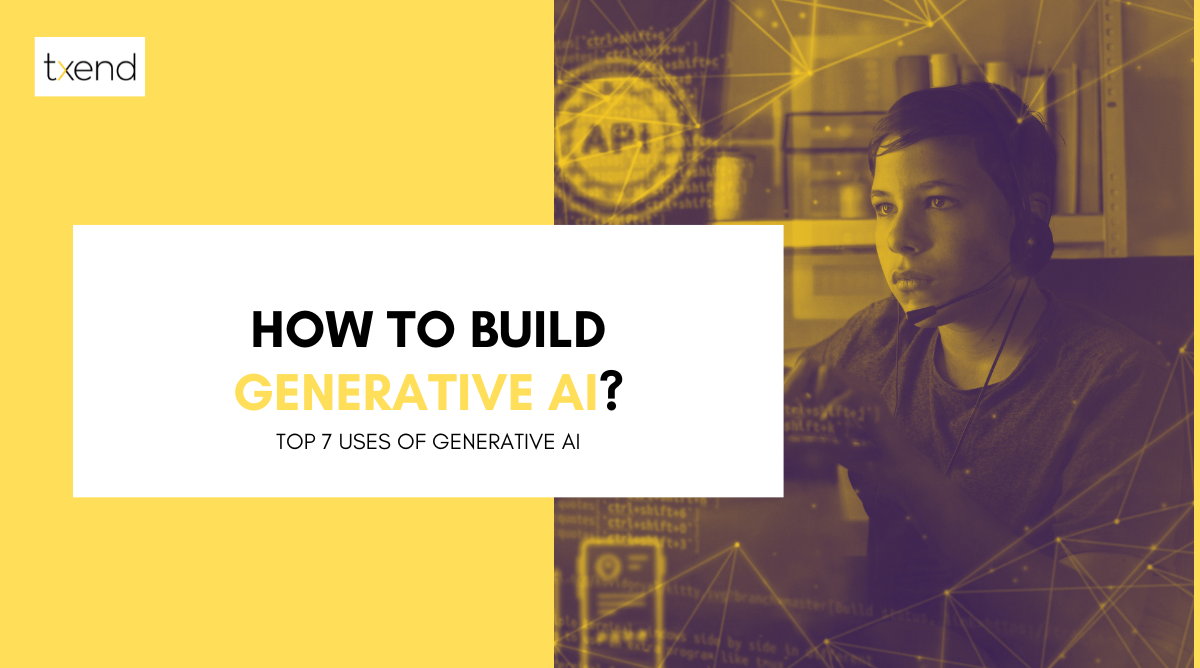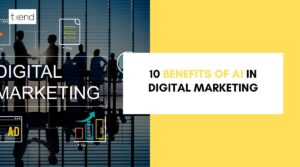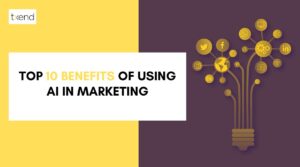In the ever-evolving landscape of artificial intelligence, one remarkable branch has captured the imagination of creators, innovators, and tech enthusiasts alike: Generative AI.
This exciting field holds the power to transform concepts into reality, enabling machines not just to understand but also to generate content, from art to text and beyond.
If you’ve ever wondered how to embark on the journey of building Generative AI or what incredible possibilities it unlocks, you’re in the right place.
This article is your comprehensive guide to the ‘how’ and ‘why’ of Generative AI. We’ll walk you through the building of Generative AI, providing insights into the coding tools and frameworks that make it all possible. But that’s just the beginning.
In addition to demystifying the creation process, we’ll delve into the ‘uses’ aspect of Generative AI. You’ll discover the top 7 real-world applications that harness the immense potential of Generative AI, opening doors to new horizons in various industries.
What is Generative AI?
Generative AI, short for Generative Artificial Intelligence, is a cutting-edge field within artificial intelligence (AI) that focuses on creating AI systems capable of generating content, such as text, images, music, and even more complex data.
These AI systems are designed to simulate human creativity and imagination, essentially enabling them to produce original content that often appears indistinguishable from what a human might create.
At its core, how to build Generative AI uses deep learning techniques, particularly a subset of machine learning known as generative models.
These models are designed to understand patterns and data distributions in the input data and then generate new content that fits those patterns. Some of the most well-known generative models include Generative Adversarial Networks (GANs), Recurrent Neural Networks (RNNs), and Transformers.
Generative AI Application Areas in the United States
Art and Design:
In the United States, Generative AI has made a significant impact on the art and design industry. Artists and designers use generative models to create unique and innovative artworks, 3D designs, and animations.
These tools enable them to push the boundaries of creativity and produce art that resonates with a global audience.
Content Creation:
Content creators, including bloggers, video producers, and social media influencers, use Generative AI to automate content generation.
From writing articles and video scripts to generating social media posts, these tools help save time and maintain a consistent online presence.
Healthcare:
In the healthcare sector, Generative AI plays a vital role in medical imaging and diagnostics. Generative models can help in generating synthetic medical images for training AI algorithms and improving the accuracy of disease detection and medical research.
Language Processing:
In the United States, businesses leverage Generative AI for natural language processing tasks. It can generate human-like text, aiding in chatbots, virtual assistants, and automated customer support, enhancing customer interactions.

Entertainment and Gaming:
Generative AI is transforming the entertainment and gaming industry. It is used to create realistic game environments, generate game characters, and even craft dynamic storylines, enhancing the immersive experience for players.
Marketing and Advertising:
In the field of marketing and advertising, Generative AI is used for personalized content recommendations, ad copy generation, and even predicting consumer preferences. This technology helps businesses target their audience more effectively and increase engagement.
Research and Development:
Generative AI is employed in research and development, facilitating drug discovery, materials science, and simulations. It accelerates the innovation process by generating hypotheses and analyzing complex data.
Generative AI is a versatile technology that continues to evolve and find new applications in the United States and beyond. Its ability to generate content, adapt to user needs, and automate creative processes makes it a transformative force in various industries, shaping the future of AI-driven innovation.
How to build Generative AI, and how does work?
Generative AI, a groundbreaking technology, operates based on advanced machine learning techniques primarily driven by deep neural networks.
In the United States, like in many other parts of the world, Generative AI is utilized to accomplish various tasks, and its functionality is underpinned by several key principles:
Neural Networks:
Generative AI heavily relies on neural networks, particularly recurrent neural networks (RNNs) and, more recently, generative adversarial networks (GANs) and transformer models. These networks are designed to mimic the human brain’s ability to learn and adapt.
Training Data:
Generative AI systems in the United States are trained on extensive datasets that contain examples of the kind of content they’re expected to generate. For instance, a text-based Generative AI model might be trained on a vast corpus of text to understand language patterns.
Learning Patterns:
During the training phase, Generative AI models learn the statistical patterns and relationships in the data. They discern the structures, styles, and features that define the content they’re meant to generate, whether it’s text, images, or other forms of data.
Generative Models:
Generative AI systems, after training, create content by using generative models. These models take a seed input, often called a “latent vector” for images or an initial sequence for text, and expand upon it to generate new, creative content.

Feedback Loops:
Some Generative AI models involve feedback loops, such as GANs, which consist of a generator and a discriminator. The generator creates content, and the discriminator evaluates it.
They engage in a feedback loop, with the generator aiming to produce content that is increasingly convincing to the discriminator.
Fine-Tuning:
In the United States, Generative AI models are often fine-tuned for specific tasks. This involves adapting a pre-trained model to perform particular functions, like generating art, writing code, or creating music.
Ethical Considerations:
Ethical considerations are of paramount importance. In the U.S. and elsewhere, concerns about the misuse of Generative AI, like generating fake news or deepfakes, have led to increased attention on responsible AI use and mitigation of potential harms.
Real-World Applications:
Generative AI in the United States finds applications in various fields, including content generation, art, healthcare, marketing, and more. These applications are powered by the ability of Generative AI to generate content that is creative, insightful, and tailored to specific needs.
Generative AI Tech Stack: Powering the Future
PyTorch and TensorFlow:
PyTorch and TensorFlow are two of the most popular machine learning frameworks. They provide a set of tools and libraries that make it easy to develop and train machine-learning models.
Generative AI models are typically trained using deep learning algorithms, so it is important to choose a framework that is well-suited for deep learning.
Jupyter Notebook:
Jupyter Notebook is a popular development environment for machine learning. It provides a web-based interface where you can write and execute code as well as visualize your data.
HuggingFace:
HuggingFace is a popular model library that provides pre-trained models for a variety of natural language processing tasks, including text generation, translation, and question answering. HuggingFace models can be used as the starting point for building your own generative AI models.

Pandas and OpenCV:
Pandas and OpenCV are two popular data processing libraries. Pandas is used for manipulating and analyzing tabular data, while OpenCV is used for manipulating and analyzing image and video data.
Generative AI models typically require large amounts of data to train, so it is important to use efficient data processing tools.
Scikit-learn:
Scikit-learn is a popular machine-learning library that provides a variety of utilities for machine-learning tasks, such as model evaluation, feature engineering, and hyperparameter tuning. Scikit-learn can be used to complement PyTorch and TensorFlow when building generative AI models.
Cloud:
Cloud computing platforms like AWS, Azure, and GCP provide scalable and affordable infrastructure for training and deploying generative AI models. Generative AI models can be computationally expensive to train, so using a cloud platform that can scale your resources up or down as needed is important.
Step-By-Step Guide How To Build Generative AI Solution
Understand the Problem:
The first step is to clearly understand the problem that you are trying to solve with generative AI. What kind of output do you want to generate? What kind of data do you have available to train the model? What are the constraints on your solution, such as budget, time, and computing resources?
Select the Appropriate Model, Algorithms, and Tools:
Once you understand the problem, you can start to select the appropriate model, algorithms, and tools for building your generative AI solution.
There are a variety of different models and algorithms available, each with its own strengths and weaknesses. You will also need to choose the right tools for training and deploying your model.
Gather and Process Data for Training:
Generative AI models require a lot of data to train. The quality and diversity of your data will have a significant impact on the performance of your model. Once you have gathered your data, you will need to process it so that it is in the correct format for training your model.
Create a Proof of Concept:
Before you invest a lot of time and resources into training a full-scale generative AI model, it is important to create a proof of concept.
This will help you to validate your approach and identify any potential problems. To create a proof of concept, you can train a small generative AI model on a subset of your data.
Train the Model (Optional):
If you are satisfied with the results of your proof of concept, you can then train a full-scale generative AI model on your entire dataset.
This can be a time-consuming and computationally expensive process, so it is important to make sure that you have the necessary resources available.

Integrate It Into the Application:
Once your model is trained, you need to integrate it into your application. This may involve developing an API, creating a user interface, or connecting to other systems.
Testing & Adjusting Parameters:
Once your model is integrated into your application, you need to test it thoroughly and adjust the parameters as needed. This will help to ensure that your model is performing as expected and producing high-quality outputs.
Publish:
Once you are satisfied with the performance of your model, you can publish it so that others can use it. This may involve making your model available as an API, releasing it as open-source software, or commercializing it.
Monitor & Improve:
Once your model is published, you should continue to monitor its performance and make improvements as needed. This may involve gathering user feedback, collecting new data, and retraining the model.
Here are some examples of how generative AI is being used in the US:
Healthcare:
Generative AI is being used to develop new drugs and treatments, diagnose diseases, and create personalized treatment plans.
Finance:
Generative AI is being used to detect fraud, predict market trends, and develop new financial products and services.
Manufacturing:
Generative AI is being used to design new products, optimize production processes, and predict maintenance needs.
Media and entertainment:
Generative AI is being used to create new forms of art and entertainment, personalize content for users, and generate realistic special effects.
Customer service:
Generative AI is being used to develop chatbots and virtual assistants that can provide customer support.
These are just a few examples, and there are many other ways that generative AI is being used in the US. As generative AI continues to develop, it is likely to have an even greater impact on our lives.
How Generative AI Is Changing Industries?
Fintech:
Generative AI can be used in fintech to develop new financial products and services, such as personalized investment advice, fraud detection, and risk assessment.
For example:
A fintech company could use generative AI to develop a chatbot that can provide personalized financial advice to customers based on their individual financial situation and goals.
Healthcare:
Generative AI can be used in healthcare to develop new drugs and treatments, diagnose diseases, and create personalized treatment plans.
For example:
A pharmaceutical company could use generative AI to develop new drug candidates, or a hospital could use generative AI to develop personalized treatment plans for cancer patients.
Real estate:
Generative AI can be used in real estate to generate virtual tours of properties, predict property values, and identify potential investment opportunities.
For example:
A real estate company could use generative AI to generate virtual tours of properties that are still under construction, or an investor could use generative AI to identify potential investment properties that are likely to appreciate in value.
Ecommerce:
Generative AI can be used in ecommerce to personalize product recommendations, generate marketing copy, and detect fraud.
For example:
An ecommerce company could use generative AI to personalize product recommendations to customers based on their past purchase history, or a payment processor could use generative AI to detect fraudulent transactions.
Education:
Generative AI can be used in education to create personalized learning experiences, generate educational content, and assess student performance.
For example:
An educational technology company could use generative AI to create personalized learning plans for students based on their individual learning needs, or a teacher could use generative AI to generate educational content, such as practice problems or quizzes.
Legal:
Generative AI can be used in the legal field to research case law, generate legal documents, and identify potential legal risks.
For example:
A law firm could use generative AI to research case law for a client’s case, or a company could use generative AI to identify potential legal risks associated with a new product or service.

Manufacturing:
Generative AI can be used in manufacturing to design new products, optimize production processes, and predict maintenance needs.
For example:
A manufacturing company could use generative AI to design a new product that is both lightweight and durable, or a factory could use generative AI to optimize its production process to reduce waste and increase efficiency.
These are just a few examples of how generative AI can be used in different industries. As generative AI continues to develop, we can expect to see even more innovative and groundbreaking applications.
More Useful Tips For Building Generative AI Solutions
Start small and simple:
Don’t try to build a complex generative AI solution right away. Start with a simple problem, such as generating text or images, and then gradually increase the complexity of your solution as you gain more experience.
Use pre-trained models:
Pre-trained generative AI models are available for a variety of tasks, such as text generation, translation, and image generation. These models can save you a lot of time and effort, especially if you are new to building generative AI solutions.
Use a cloud platform:
Cloud platforms provide scalable and affordable infrastructure for training and deploying generative AI models. Training generative AI models can be computationally expensive, so it is important to use a platform that can scale your resources up or down as needed.
Monitor and improve your model:
Once your generative AI model is deployed, you should continue to monitor its performance and make improvements as required. This may involve gathering feedback from users, collecting new data, and retraining the model.
How Much Does It Cost To Build A Generative AI Solution?
The issue of affordability arises when considering the development of generative AI software. Notably, the model must be trained and deployed, which is expensive. You start to worry that you might be looking at an expensive cost if you include in the typical development activities.
But is creating AI so expensive?
The complexity of the answer and what you’re trying to produce will determine this. You will only have to spend a fortune to publish an AI-powered app if you create a generic AI tool like ChatGPT.
Frequently Asked Questions
Transfer learning allows us to use what we have already learned to solve new problems, which can be very useful for generative AI, which often requires a lot of data and computing power to train.
Generative AI models can be integrated into existing systems through APIs, custom software, or by connecting directly to data sources and other systems.
Training large-scale generative AI models is challenging due to the high computational cost and the need for high-quality data.
Generative models learn the joint distribution of data, while discriminative models learn the conditional probability of output given input.
Collect data, choose a model, train the model, evaluate the model, and fine-tune the model.
Conclusion:
In this journey through the world of How to Build Generative AI, we’ve explored the intricacies of building and implementing this remarkable technology.
We’ve delved into the tools, frameworks, and models that power its creation, and we’ve uncovered the top seven uses of Generative AI, showcasing its transformative potential across various industries.
Generative AI is not merely a futuristic concept; it’s a tangible reality shaping the present and future in the United States and worldwide.
From its remarkable ability to generate content in the form of text, images, audio, and video to its applications in healthcare, art, marketing, and more, Generative AI is leaving its mark on diverse sectors.
As we wrap up this exploration, it’s crucial to emphasize the profound impact of responsible and ethical use of Generative AI.
While this technology offers immense benefits, it also presents challenges, including concerns about fake content, privacy, and bias. As creators and innovators, it’s our responsibility to ensure that Generative AI is harnessed for the betterment of society.
The future holds endless possibilities for Generative AI, and its continued evolution promises even more incredible applications.
Whether it’s enhancing creative endeavors, revolutionizing healthcare, optimizing marketing strategies, or facilitating innovation in research and development, Generative AI stands at the forefront of technological advancement.
So, as we conclude, remember that the power to build and utilize Generative AI is within reach. With the right knowledge and tools, you can join the ranks of those who are harnessing this technology to drive innovation and transform industries.
As you embark on your own journey with Generative AI, keep your creativity flowing and your commitment to ethical use unwavering.
The world of Generative AI is yours to explore, and the opportunities it presents are limited only by your imagination. Embrace the potential, pioneer new horizons, and let Generative AI be your ally in creating a brighter, more innovative future.



